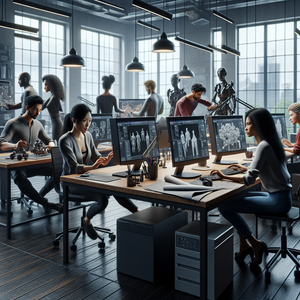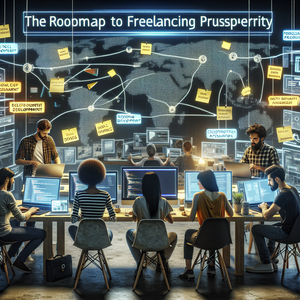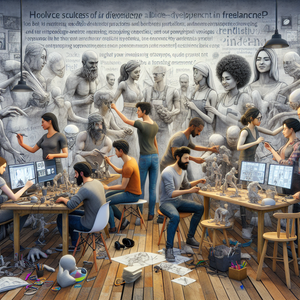
Unlocking the Potential: Your Journey into Freelance 3D Modeling Careers
The digital age is here, and with it comes an explosion of opportunities for talented individuals in the realm of freelance 3D modeling. Industries like entertainment, gaming, architecture, and product design are on the lookout for skilled 3D modelers who can bring their visions to life. From crafting intricate characters for video games to developing stunning architectural visualizations, the roles available in this field are as diverse as they are rewarding. If you’re contemplating a career in freelance 3D modeling, this guide will illuminate the various paths you can take, the skills you'll need, and the strategies for building a successful career.
Job Summaries:
Freelance 3D Modeler:
- As a freelance 3D modeler, you’ll be responsible for creating three-dimensional representations of objects, environments, or characters.
- Your primary tools will be software like Blender and Maya.
- Your ability to communicate effectively with clients will be key to delivering on their visions.
Freelance 3D Artist:
- Specialize in creating visual content through 3D modeling.
- Focus on specific niches such as character design or architectural visualization.
- Master design principles and software like Cinema 4D or ZBrush.
- Stand out in a competitive marketplace.
3D Animator:
- If you’re drawn to the art of movement, consider becoming a 3D animator.
- You'll design storyboards.
- Develop character models.
- Breathe life into animations using tools like Autodesk Maya.
- A strong portfolio showcasing your animation skills is essential here.
3D Rendering Specialist:
- These specialists create photorealistic images from 3D models.
- These images are crucial for marketing and product design.
- Knowledge of rendering software, such as V-Ray or Corona Renderer, is essential.
- A good grasp of lighting and materials is important.
- These skills will ensure your visuals captivate audiences.
Technical Artist:
- Bridging the gap between artists and developers.
- Technical artists optimize art assets for performance in games and applications.
- A dual background in art and programming enhances troubleshooting capabilities.
- Familiarity with engines like Unreal or Unity is beneficial.
3D Character Modeler:
- Creating detailed character models requires a deep understanding of anatomy and character design principles.
- Proficiency in ZBrush and collaboration with animators are crucial for seamless integration into projects.
3D Environment Artist:
- Environment artists craft immersive worlds
- Focusing on terrains and buildings
- Ensuring a cohesive visual narrative
- Strong artistic skills are key in this role
- Proficiency in software like 3ds Max or Blender is essential
3D Product Designer:
- For those inclined towards consumer products, 3D product designers develop detailed models for marketing and prototyping.
- Familiarity with CAD software like SolidWorks and knowledge of materials are essential.
3D Visual Artist:
- Blending graphic design with 3D modeling
- Visual artists create engaging graphics for both print and digital media
- Mastery of Adobe Creative Suite is crucial here
3D Game Designer:
- Focusing on video game assets
- 3D game designers ensure that visual elements align with gameplay mechanics
- Familiarity with game engines like Unity or Unreal Engine is vital.
3D Illustrator:
- Combining traditional techniques with 3D modeling, 3D illustrators create unique visuals.
- A robust portfolio and creative vision are important.
Freelance 3D Printing Designer:
- These designers specialize in creating models for 3D printing.
- They require an understanding of printing processes and CAD software.
- Attention to detail is paramount for functionality and aesthetics.
3D Texture Artist:
- Texture artists enhance the realism of 3D models through textures and materials.
- Software like Substance Painter is essential for this work.
3D Lighting Artist:
- Lighting artists manipulate light within 3D environments to create mood.
- Strong artistic skills and collaboration with other creatives are vital.
3D Simulation Designer:
- These designers create realistic simulations for training and entertainment.
- Leveraging software like Unity.
- Problem-solving skills and technical proficiency are crucial.
3D Architectural Visualizer:
- Architectural visualizers produce representations of designs.
- Helping clients visualize projects pre-construction.
- Proficiency in SketchUp is essential.
3D Motion Graphics Designer:
- Creating animated graphics for video content
- Motion graphics designers merge 3D modeling with graphic design
- Necessitating software skills in After Effects
Virtual Reality (VR) Developer:
- At the forefront of technology, VR developers create immersive environments.
- VR development requires both 3D modeling and programming skills.
Augmented Reality (AR) Designer:
- AR designers blend digital content with the real world
- Focusing on mobile applications and marketing
- Proficiency in 3D modeling is essential
- User experience design is essential
Freelance 3D Visual Effects Artist:
- These artists enhance storytelling through visual effects.
- Utilizing software like After Effects.
- Strong artistic skills are crucial.
- Ability to meet tight deadlines is crucial.
The world of freelance 3D modeling is rich with opportunities, each role offering its own unique contribution to the creative process. By exploring these diverse paths and understanding the skills required for each, aspiring professionals can make informed decisions about their careers. As the industry continues to evolve, embracing lifelong learning and adaptability is essential for sustained success. Whether you choose formal education or a self-directed path, remember that creativity, technical proficiency, and a willingness to evolve are the cornerstones of a thriving freelance career in 3D modeling. Consider this journey not just as a career choice, but as a chance to express your artistic vision in a world that craves creativity. The possibilities are endless, and the time to start is now.
Explore More Jobs

